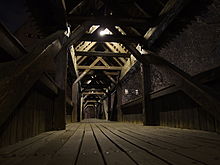Hangman's Walk
Coordinates: 49 ° 27 ′ 11 " N , 11 ° 4 ′ 23" E
| Executioner's footbridge in Nuremberg | ||
|---|---|---|
| Hangman's Bridge, 2009 | ||
| Convicted | pedestrian | |
| Subjugated | Pegnitz | |
| place | Nuremberg | |
| location | ||
|
|
||
The Henkersteg , also called Langer Steg, is a wooden footbridge over the Pegnitz in Nuremberg .
Location and surroundings
The footbridge begins at the Henkerturm and connects the flea market , an island in the Pegnitz, with the St. Lorenz district , where it leads to the Unschlittplatz next to the Unschlitthaus .
history
In 1457 a wooden walkway was built for pedestrians over the southern outflow of the Pegnitz on the penultimate city wall . He got the name Henkersteg from the executioner's tower, the former apartment of the imperial city executioner on the Säumarkt (today: flea market). During the floods of 1595, ice drift and ice jams caused damage to the bridges over the Pegnitz. The collapse of the executioner's footbridge at the end of January 1595 cost eight onlookers their lives when they were swept away by the floods with the bridge. After the flood, three city wall arches from the penultimate city fortifications were torn down and the executioner's footbridge was rebuilt further west as a covered wooden footbridge; since then the southern end of the footbridge has led to the Unschlittplatz. In 1657, 1671, 1761 and 1776 the hangman's walkway was renewed or rebuilt. After severe war damage, the footbridge was reconstructed in 1954. In 2000, it became a stop on the Nuremberg Historical Mile, which was created on the occasion of the city's 950th birthday .
Web links
- Entry at structurae
literature
- Michael Diefenbacher , Rudolf Endres (Hrsg.): Stadtlexikon Nürnberg . 2nd, improved edition. W. Tümmels Verlag, Nuremberg 2000, ISBN 3-921590-69-8 ( online ).





